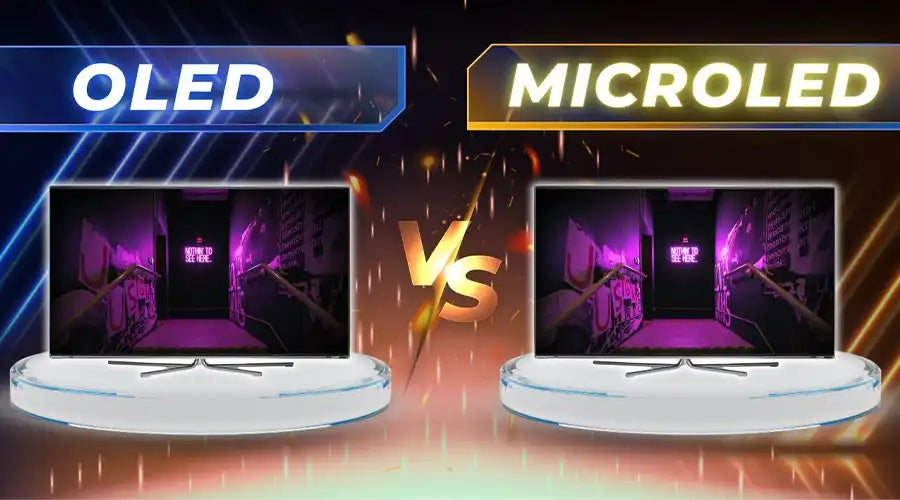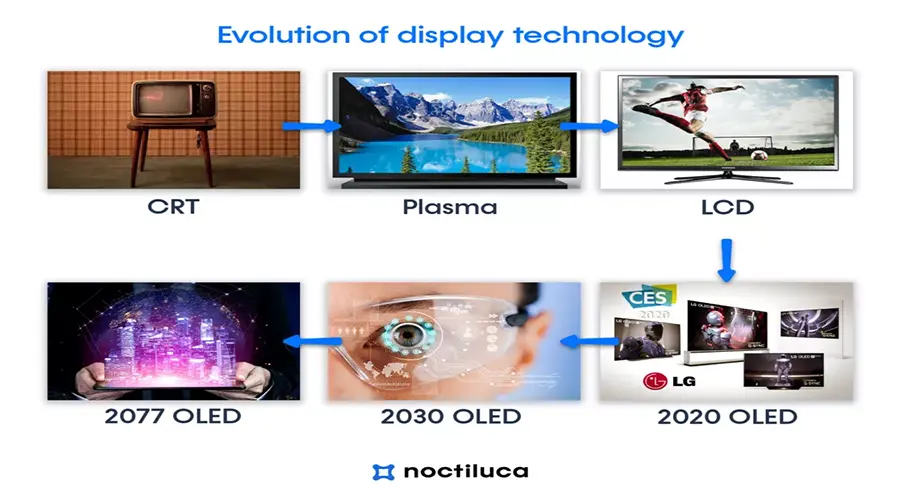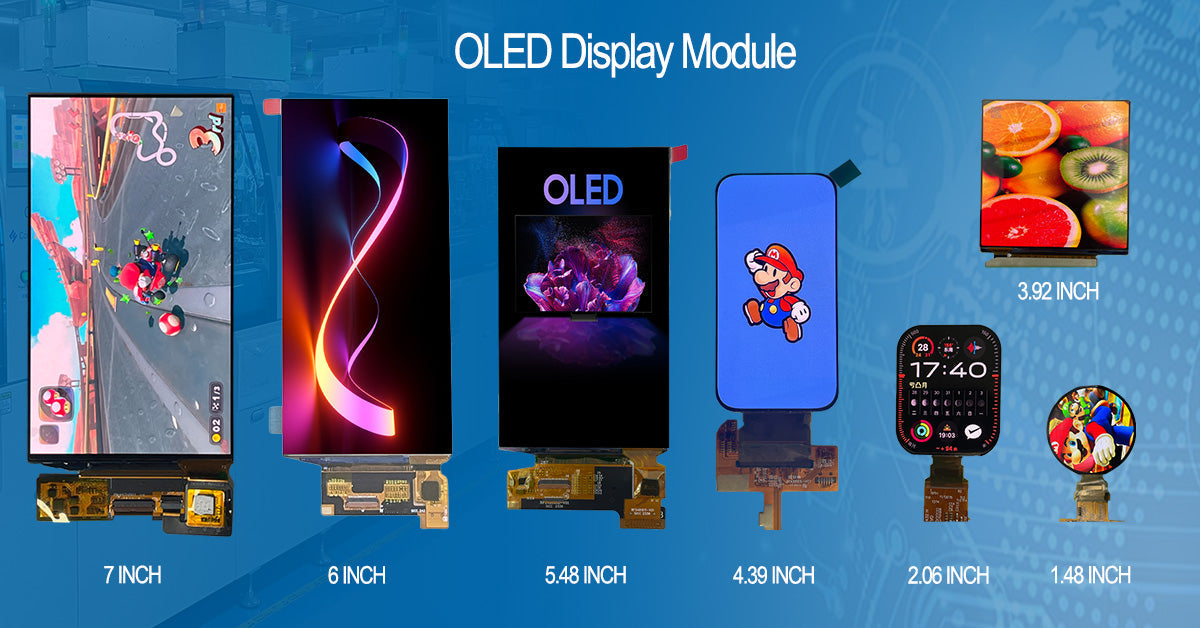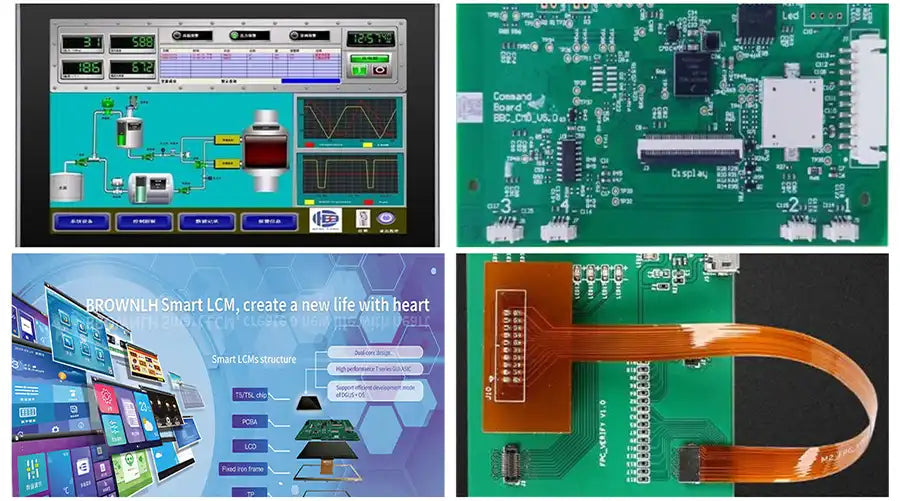OLED and MicroLED are two high-performance emissive display technologies that frequently appear in product roadmaps for smartphones, TVs, automotive screens, and AR/VR devices. This article gives an engineer-level but approachable comparison of OLED vs MicroLED, covering device physics, manufacturing, brightness & HDR, color performance, lifetime & reliability, cost & scalability, integration challenges, and real-world application guidance.
Table of Contents
- Definitions: What are OLED & MicroLED?
- Device physics & pixel architecture
- Manufacturing methods & yield factors
- Performance comparison (brightness, color, response, power)
- Reliability, burn-in & lifetime
- Scalability & cost (panels, modules, mass production)
- System integration & optical stack
- Application comparison & recommended choices
- Quick side-by-side table
- FAQ
- Conclusion & selection checklist
Definitions: What are OLED & MicroLED?
OLED (Organic Light-Emitting Diode)
OLED is an emissive display technology where organic semiconductor layers generate light when driven by an electric current. Pixels are composed of organic emissive layers sandwiched between electrodes. OLED is used in two main driver categories: PMOLED (passive matrix) for small, low-resolution displays, and AMOLED (active matrix) for high resolution and video applications. OLED panels are thin, flexible (when built on polymer substrates), and offer near-infinite contrast because black pixels emit no light.
MicroLED
MicroLED is an emissive technology that uses microscopic inorganic LED chips (GaN or InGaN) as discrete sub-pixels. Each MicroLED pixel is a tiny inorganic LED (often μm to tens of μm in size) that emits red, green, or blue light directly. MicroLED offers very high brightness, potentially superior lifetime, and excellent color because inorganic LEDs are stable and efficient. MicroLED can also enable modular large screens and very high pixel densities for AR/VR.

Device physics & pixel architecture
OLED stack and emission mechanism
An OLED sub-pixel typically includes: anode (ITO), hole-injection/transport layers, one or more emissive layers (organic small molecules or polymers), electron transport layers, and cathode. Electroluminescence occurs when injected electrons and holes recombine in the emissive layer, producing photons. Emitters can be fluorescent, phosphorescent, or TADF (thermally activated delayed fluorescence), each with tradeoffs in efficiency and lifetime.
MicroLED die and inorganic emission
MicroLED pixels are composed of inorganic LED dies—commonly GaN for blue/green and phosphor or red-LED approaches for red emission. Inorganic LEDs convert electrical energy to light via carrier recombination in a semiconductor junction. MicroLEDs are fundamentally similar to conventional LEDs but fabricated at microscopic scale and assembled into arrays.
Pixel addressing: TFT backplane vs direct drive
AMOLED uses an active-matrix TFT backplane (LTPS, LTPO, or IGZO) to address pixels and store charge. MicroLED displays can be implemented with various backplanes: direct drive, CMOS driver arrays, or hybrid active matrices. MicroLED's small die size allows direct current drive with very fast switching and excellent control.
Manufacturing methods & yield factors
OLED manufacturing process
OLED manufacturing typically involves deposition of organic layers via vacuum thermal evaporation (using fine metal masks — FMM) for RGB, or soluble inkjet printing for some architectures. The backplane is produced with high-temperature processes for TFTs. Encapsulation (glass or thin film encapsulation) is critical to protect organics from moisture and oxygen. Yield losses can occur from particles, mask defects, and encapsulation failures.
MicroLED manufacturing & mass transfer challenge
The primary manufacturing hurdle for MicroLED is mass transfer: placing millions (or billions in high PPI devices) of microscopic LED dies onto a target substrate with high accuracy and yield. Approaches include elastomeric stamp transfer, fluidic assembly, laser-assisted transfer, and wafer-bonding. Each method trades throughput, cost, and yield. Additionally, MicroLED requires fine pitch driver integration and sometimes per-pixel testing/repair (redundancy or self-repair needed to manage defects).
Performance comparison
Brightness & HDR performance
MicroLED excels in peak brightness because inorganic LEDs can sustain high current densities and retain efficiency at high drive. MicroLED can achieve several thousands to tens of thousands of nits in modular configurations, ideal for outdoor signage and HDR displays. OLED/AMOLED achieves excellent HDR highlights in phones and TVs (commonly 1000–3000 nits peak on small areas) but large-area full-screen brightness is thermally and lifetime limited.
Color gamut, accuracy & spectral purity
MicroLED has intrinsic spectral advantages because each LED die emits a narrow spectrum; color purity can be excellent with minimal filtering. OLED color can be tuned via emitter chemistry and color filters, and high color gamuts (DCI-P3, Rec.2020 approaches) are achievable. Factory calibration on AMOLED panels often yields ΔE < 2 for consumer products.
Response time & motion clarity
Both OLED and MicroLED have microsecond-class material responses, providing near-instant switching and negligible smear compared to LCDs. MicroLED's inorganic LED switching is inherently fast and the active driver architectures commonly used support very high refresh rates suitable for gaming and microdisplays in XR devices.
Power consumption models
Power depends on displayed content. OLED power scales with lit pixel area and luminance; pure black content is very power efficient. MicroLED similarly scales with lit pixel area but generally offers higher efficiency at high brightness levels. For always-on, high-APL signage, MicroLED may be more power efficient per nits delivered.

Reliability, burn-in & lifetime
OLED aging & burn-in
OLED organic emitters degrade with cumulative electrical stress; blue emitters historically degrade fastest, causing color shifts and potential burn-in for static high-contrast elements. Manufacturers use material engineering, pixel layouts (larger blue sub-pixels), pixel shifting, and compensation algorithms to mitigate these effects. Typical consumer expectations are T95/T80 lifetimes in tens of thousands of hours under specified operating conditions.
MicroLED longevity
MicroLED uses inorganic semiconductors with superior operational stability and lifetime compared to organic emitters. MicroLED is far less prone to burn-in and can sustain higher continuous luminance with minimal long-term degradation. This makes MicroLED attractive for applications demanding long life and high brightness (e.g., public displays, automotive HUDs).
Environmental robustness & encapsulation
OLED requires robust encapsulation to prevent moisture ingress. MicroLED is more robust by nature, but packing small dies and ensuring mechanical protection is vital; optical bonding and protective coatings are commonly used.
Scalability & cost (panels, modules, mass production)
OLED: mature scale, competitive price
OLED benefits from established production lines, high yields for common mobile sizes, and economies of scale. As a result, OLED panels are comparatively cost-effective for smartphones, TVs, and wearables at present.
MicroLED: high potential, current cost premium
MicroLED carries significant manufacturing complexity, particularly for high PPI small panels. Mass transfer, die repair, and driver integration are cost drivers. However, for large modular displays (video walls) and specialty AR microdisplays, MicroLED can be economically attractive due to modularity and high brightness density.
System integration & optical stack
Optical coatings & reflectance control
Both technologies benefit from anti-reflective (AR) coatings, circular polarizers (to reduce glare), and optical bonding to improve contrast and durability. MicroLED systems often need microlenses or diffuser elements at very small pitches to smooth pixel visibility and fill factor.
Touch & sensor integration
Integrating touch sensors, proximity sensors, or fingerprint readers is routine for AMOLED. MicroLED modules require careful co-design to accommodate on-panel drivers and touch layers without compromising optical efficiency.
Application comparison & recommended choices
Smartphones & tablets
Today, AMOLED is the de-facto premium smartphone display due to its balance of cost, color, HDR performance, and variable refresh implementations (LTPO). MicroLED mobile phones are technically feasible but limited by microtransfer cost. Expect MicroLED when manufacturing solves small-die transfer economically.
Large TVs and home theater
OLED TVs deliver exceptional contrast and cinematic blacks; QD-OLED and MiniLED+LCD are complementary options. MicroLED is emerging at the top tier with modular large panels that achieve extreme brightness and lifetime — ideal for bright rooms or commercial cinema.
Outdoor signage & professional displays
For high-brightness outdoor displays and video walls, MicroLED is uniquely positioned due to its superior nits, energy efficiency at high luminance, and long lifetime. OLED is less common for permanently bright signage due to lifetime and brightness constraints.
AR/VR and microdisplays
MicroLED microdisplays are a major opportunity for AR/VR because they can reach very high pixel densities with high brightness and contrast. AMOLED microdisplays exist too, but MicroLED's inorganic nature offers better lifetime for high-brightness near-eye applications.
Automotive & cockpit
Automotive requires high brightness, wide temperature tolerance, and long life. High-end cockpit displays and HUDs often favor MicroLED or automotive-qualified AMOLED variants with rigorous encapsulation and burn-in mitigation.

Quick side-by-side comparison
| Category | OLED / AMOLED | MicroLED |
|---|---|---|
| Peak Brightness | High for small areas (phone HDR highlights), limited full-screen | Very high; thousands to tens of thousands nits possible |
| Contrast & Blacks | Excellent (true blacks) | Excellent (true blacks) |
| Lifetime & Burn-in | Organic decay; burn-in risk for static content | Inorganic; superior longevity and minimal burn-in |
| Color Purity | High; depends on materials & filters | Very high; narrow spectra per LED die |
| Manufacturing Maturity | Mature, high yield for consumer sizes | Emerging; mass transfer/yield remain challenges |
| Cost (2024–2026) | Lower for mainstream phones & TVs | Higher, premium for specialized applications |
| Best Use Cases | Phones, TVs, wearables, flexible displays | High-brightness signage, AR/VR microdisplays, premium modular walls |
FAQ — OLED vs MicroLED
1. Is MicroLED better than OLED in every way?
Not yet. MicroLED offers superior brightness and longevity, but manufacturing cost and small-die mass transfer for high PPI small displays remain challenges. OLED/AMOLED is currently more cost-effective for smartphones and TVs.
2. Will MicroLED replace OLED?
MicroLED will complement and in some niches replace OLED (e.g., bright signage, AR/VR, modular video walls), but OLED will remain relevant for many mainstream consumer devices for the near term due to manufacturing maturity and cost.
3. Which is better for AR/VR?
MicroLED microdisplays are highly promising for AR/VR due to high pixel density and brightness. AMOLED microdisplays are also used, but MicroLED has intrinsic advantages for long-term high-brightness operation.
4. Are there hybrid technologies to consider?
Yes. QD-OLED, MiniLED backlit LCD, and MicroLED hybrids (e.g., color conversion layers) are part of the ecosystem — each balances cost, color, brightness and manufacturability differently.
5. What should product teams prioritize when choosing?
Define your target: (1) required peak luminance & APL, (2) lifetime target & burn-in tolerance, (3) PPI & form factor, (4) cost budget, (5) integration constraints (touch, sensors). Use a decision matrix to weigh tradeoffs objectively.
Conclusion & selection checklist
In practical product development, choose AMOLED/OLED when you need proven, cost-effective, high-contrast displays for phones, TVs, and wearables. Choose MicroLED when your product requires extreme brightness, long lifetime, modularity, or the ultimate microdisplay performance (AR/VR). The display decision should be driven by a concise spec: peak brightness (nits), average picture level (APL), lifetime target (hours), PPI, thermal envelope, and production cost per unit.
Share target size, PPI, expected duty cycle (hours/day), environmental range, and brightness needs — we’ll propose OLED or MicroLED candidates with optical/electrical specs and cost considerations.






コメントを書く
このサイトはhCaptchaによって保護されており、hCaptchaプライバシーポリシーおよび利用規約が適用されます。